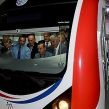
Turkey’s Undersea Marmaray Railway Tunnel Unites Europe, Asia
Publication: Eurasia Daily Monitor Volume: 10 Issue: 194
By:

Inaugurated on October 29, 2013, the 90th anniversary of the founding of the Republic of Turkey, Istanbul’s undersea Marmaray railway tunnel is the world’s first connecting two continents and is designed to withstand earthquakes up to 9.0 on the Richter scale.
Turkey’s Prime Minister Recep Tayyip Erdogan, President Abdullah Gul, Japanese Prime Minister Shinzo Abe, Romanian Prime Minister Victor Ponta, Somali President Hasan Sheikh Mahmud and a host of foreign dignitaries were in attendance at Marmaray’s official opening. Erdogan observed that the project “connects history and future, past and the future, as well as connecting continents; Marmaray connects people, nations and countries.” Japanese Prime Minister Abe called on everybody to dream of a high-speed train beginning in Tokyo and passing through Istanbul on the way to London (https://www.aksam.com.tr/siyaset/erdogan-tokyo-pekin-londra-istanbul-olur-mu-olur/haber-256529).
The undersea engineering project was first proposed by Ottoman Sultan Abdulmecid I in 1860, but 19th century technology was not up to the task (https://www.hurriyet.com.tr/planet/25003381.asp). Sultan Abdulhamid II had architects submit proposals in 1891, but the plans were not carried out.
The concept was revived in 1902, but no further progress was made until a feasibility study was commissioned in 1985. Revised in 1997, this work formed the basis of the current project. Construction began in 2004, but when archaeological excavations uncovered the Byzantine Theodosios harbor, work was delayed. Eventually 40,000 objects were excavated from the site, including 30 Byzantine vessels, the largest known medieval fleet (https://www.dw.de/marmaray-a%C3%A7%C4%B1ld%C4%B1/a-17189036).
The Marmaray’s section under the Bosporus is 0.8 miles long, but in total the tunnel and its attendant structure stretches a length of 8.5 miles in all. The world’s deepest underwater railway tunnel, Marmaray is submerged under 184 feet of water and will be capable of carrying 75,000 people per hour in either direction.
Marmaray was built by a consortium that included Japan’s Taisei Corp. with Turkish partners Nurol and Gama. The bulk of financing came from the Japan Bank for International Cooperation (JBIC), which lent $950 million under a long-term low-cost loan, while the European Investment Bank (EIB) provided an $893 million soft loan. According to Japanese Prime Minister Abe, since 1999, when the JBIC and Turkey signed a financing agreement, Japan had provided in total more than $1.45 billion for the realization of the Marmaray project (https://www.hurriyetdailynews.com/marmaray-marks-warm-turkey-japan-ties-abe.aspx?pageID=238&nID=56950&NewsCatID=338)
Following its official opening, Marmaray will be free of charge for 15 days, after which tickets will cost $3.12.
Marmaray is viewed in Ankara as having larger strategic implications. Speaking, on August 16, at the third summit of the Cooperation Council of Turkic Speaking States in Gabala Azerbaijan, Turkish President Gul made the geopolitical implications of the railway expansion clear: “The Turkic-speaking countries need to restore the historic Silk Road, which has both political and economic significance for the world. The modern concept of the Silk Road comprises collaborative energy, transport and logistics projects that will aid the development of the entire region. All of these projects will transform the Turkic world into the center of the world economy and development,” making particular mention of the construction of the Baku-Tbilisi-Kars (BTK) railway, scheduled to become operational next year. Combined with the Marmaray rail tunnel in Istanbul, the BTK will provide a direct rail link between West Asia and Europe (https://www.turkeyanalyst.org/publications/turkey-analyst-articles/item/54-turkeys-dynamic-railway-expansion-has-larger-regional-implications.html).
Not everyone is convinced of the safety of Marmaray. The Bosporus lies in a seismically active area, with the North Anatolian Fault just 11 miles to the south in the Sea of Marmara. According to Turkey’s Ministry of Transport General Directorate of Railways, Harbors and Airports (DLH), there is a 65-percent probability of an earthquake measuring 7.5 on the Richter scale occurring within the next 30 years (https://www.timeturk.com/tr/2013/10/29/20-soruda-marmaray-yenilikler-ve-elestiriler-ne.html).
Chamber of Turkish Engineers and Architects (TMMOB) member Suleyman Solmaz commented, “Firstly there are no safety wagons; secondly, there is no electronic security system. The tunnel about to open does not have a safety control center. It would be murder to open it under these conditions.” Solmaz quoted an engineer who worked for eight years on the project, Riza Behcet Akca, as saying, “I would not get in [the Marmaray], and nobody should” (https://www.radikal.com.tr/turkiye/tmmob_marmarayda_yuksek_guvenlik_riski_var-1157792).
Another skeptic is Istanbul Chamber of Urban Planners president Tayfun Kahraman, who remarked on Marmaray, “The part that is in service is very limited. All that has been delayed until much later. We are wondering why this inauguration is happening so soon” (https://www.bbc.co.uk/news/world-europe-24721779).
Last but not least, Erdogan and Abe’s vision of Marmaray as the centerpiece of a Eurasian railway network connecting East and West is still beset by political considerations beyond Turkey’s borders. The oft-delayed BTK railway has been a hostage to Georgian politics, as earlier this month President Mikheil Saakashvili charged the government of Prime Minister Bidzina Ivanishvili with “artificial obstacles” to the construction of the BTK railway (see EDM, October 17).
Whatever the final role of the Marmaray tunnel in the Eurasian scheme of things, it at last bridges a natural obstacle that forced Xerxes I of Persia in 480 B.C.E., on his way to invade Greece, to build a pontoon bridge across the Hellespont to travel from Asia to Europe. Accordingly, the Marmaray tunnel bridges a natural barrier that has shaped Eastern Mediterranean politics for over two millennia, making Ankara’s pride in its accomplishment quite understandable.




